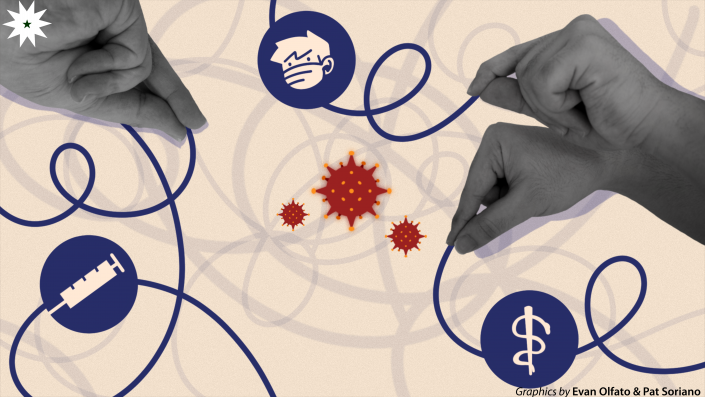
The long and arduous fight against the COVID-19 pandemic has been an uphill battle faced by all sectors of society, but one that is particularly reliant on the presence of healthcare workers. They take the challenges head-on from the frontlines to the vaccine rollout, even if the challenges stem from a deeply flawed healthcare system.
However, as cases pile up and the COVID-19 response unfurls, their lines of work become more urgent in demand. As volunteers fill in the gaps and persevere to provide quality healthcare for all, the serious risks and fatigue that come with their job description are no laughing matter.
Seizing opportunities
Vaccine volunteers come from all walks of life. Saab Antonio, a third-year medical student from De La Salle Medical and Health Sciences Institute, tells The LaSallian that she initially hesitated from stepping up. She was still a fledgling medical student, and the daily travel to and from the vaccine site would be tiring. But then, a groupmate of hers encouraged her to sign up, and she ultimately took the opportunity to volunteer with the Philippine Red Cross vaccination program in Mandaluyong.
Antonio was tasked with monitoring vitals such as blood pressure and blood glucose, but the priority was always making sure patients were comfortable. A big part of her role is addressing patients’ concerns and informing them of the do’s and don’ts. “My biggest takeaway from this experience was being able to build a healthcare provider-patient relationship,” she shares.
Meanwhile, registered nurse Carmela Perpetua-Baltazar was directly hired by the Department of Health (DOH) to assist in administering vaccines in Bustos, a municipality in the province of Bulacan. Spending every day near many people is a risky undertaking, but Perpetua-Baltazar is mindful of what is at stake when there’s a lack of manpower. “I want to help our community…It will also lessen the growing number of COVID cases in the municipality,” she stresses.
Challenging times
For those eager to be vaccinated, The slow and tedious process of administering vaccines may not sit well with everyone. “Occasionally, there are misunderstandings with some patients regarding the long waiting period. Others are frustrated over uncomfortable circumstances like the weather, for example, but we cannot please everybody,” Perpetua-Baltazar opines. In response, she and many vaccine volunteers tend to the frustrations of their patients by reassuring them that they will keep the process as smooth as possible.
While the pandemic continues to send the world into a frenzy, misinformation continues to spread. She has encountered patients who want to be protected from the virus but clung to unfounded notions about the vaccine. “Some [believed that] if you get vaccinated, you must not do a swab test afterward because it will infect you with COVID-19,” she shares. “[Others] thought that the vaccines contained microchips.”
Misinformation poses a serious threat to public health, especially if the only protection against a deadly virus is feared by many. Perpetua-Baltazar feels that it is her responsibility as a healthcare professional to disprove fake news in any way she can. A few instances prompted her to “show the syringe to patients,” one that is too small to contain microchips. After imparting the vaccine’s benefits and how to manage any resulting side effects, patients eventually agree to be vaccinated.
Antonio also insists that vaccine hesitancy should be addressed by being well-educated about the vaccine. She urges those who are informed and educated to reach out to their peers and “provide right information backed with scientific data from verified health organizations.”
A collective response
Despite coming from different vaccine programs, both volunteers felt satisfied with the way their respective rollouts have been conducted thus far. Antonio attributes her program’s success to Red Cross’ experience as an international organization. “I encountered a patient who personally commended the Philippine Red Cross for the smooth flowing and systematic vaccination experience,” she recalls.
Likewise, Perpetua-Baltazar also commended the vaccine rollout of Bustos, explaining, “We’ve been managing all our resources just to make sure that the vaccination program is as organized as possible.” As of August 15, the province of Bulacan has administered first doses to 13.8 percent of its population, while 13 percent are now fully vaccinated. On top of that, plans to have a mobile vaccination site have also been recently implemented to supplement their current efforts.
A ways to go
While Antonio sees the vaccine rollout program as an overall positive, she does note that vaccination is only one part of the national response and there is much room for the government to bolster its efforts in containing the pandemic. On top of solving the lackluster budgeting of the DOH, she believes effective leadership must be prioritized. “Qualified leaders should be placed in positions to initiate well-constructed plans and execute them with the goal in mind to achieve the new normal,” she says.
As more doses swoop in, vaccination efforts throughout the country gain steam. But while the concept of Filipino resilience is often inappropriately glorified by the media, it is the active participation of healthcare workers that is responsible for strides against the pandemic.
However, the recent implementation of yet another enhanced community quarantine is indicative of the government’s ineptitude toward enforcing effective safety measures. With daily cases spiking to over 10,000 and President Duterte’s “no vaccine, no ayuda” remarks causing panic, citizens are in disarray and crowding vaccination sites, which may ironically cause the virus to be transmitted even more. At this point, the speed of transitioning out of repeated quarantines is dependent on how efficiently the government utilizes this period to provide our countrymen with sufficient aid so that the efforts of people like Antonio and Perpetua-Baltazar do not go to waste.
